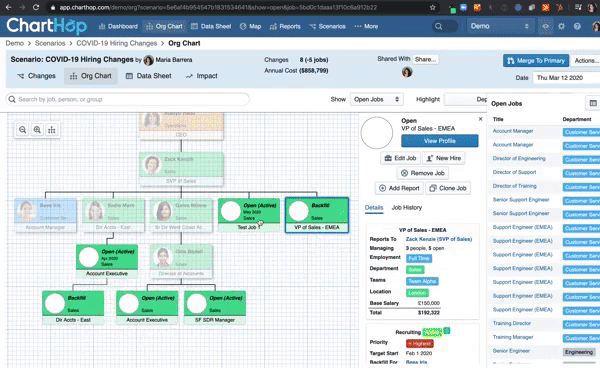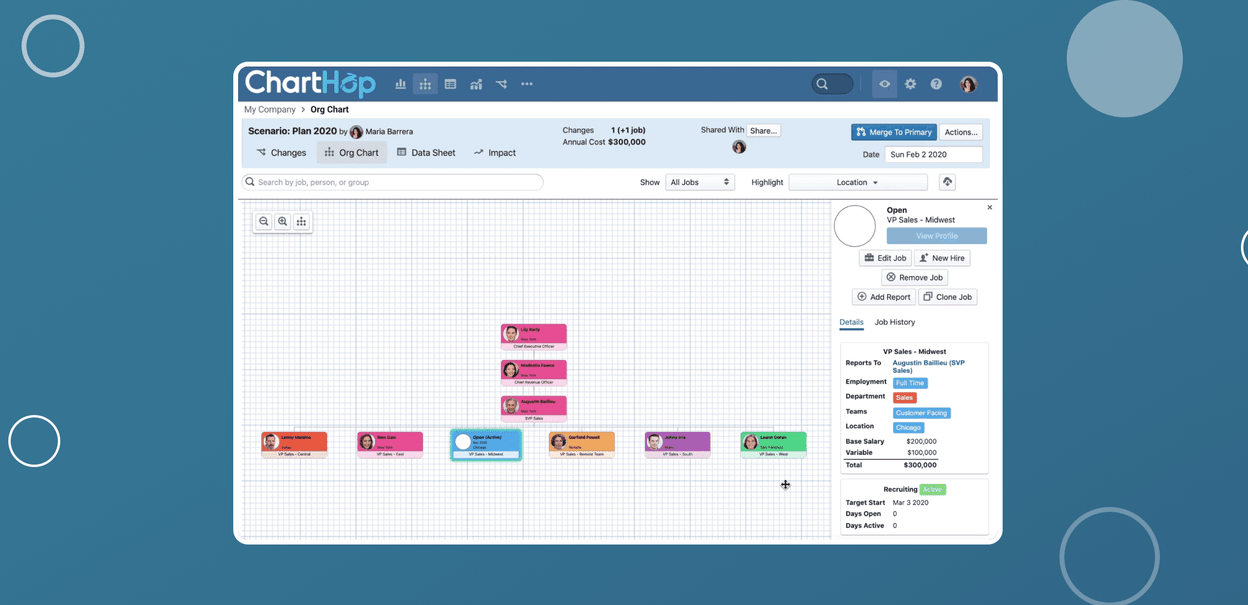Scenarios enable organizations to easily and thoughtfully react, adapt, and plan. Whether you need to propose one individual net-new headcount to your engineering team or you need to design a brand new growth-mode plan for your go-to-market team, you can use scenarios to workshop ideas, test out changes before deploying them, and manage key workflows within your organization.

The beauty of using ChartHop means you no longer need to plan to plan (making copies of spreadsheets, preparing templates for the management team, etc.) and instead can focus on the strategy.
Planning can now be a continuous process that provides new insights and direction as business conditions evolve.
It is no longer just planning — it’s reacting, adapting, hypothesizing — and enabling a new level of strategizing that was previously unachievable.
Below are some of the most commonly use cases for Scenario building:
1. Annual Planning Cycles
How can you coordinate data-driven decision making and promote visibility across management, leadership, and key stakeholders (without 100s or 1,000s of emails, spreadsheets, and excess meetings)?
Power your existing review process by adapting your workflows to exist within ChartHop and leverage Scenarios. Use it for Annual / Quarterly Compensation Reviews, Headcount Planning, and Promotion & Performance Reviews.
Example Workflow:
- Phase 1: Front-line manager and management input and data entry
- Phase 2: Department leadership and exec approval and recommendations
- Phase 3: FP&A and People review, analysis, calibration, and approval
2. Org Design and Restructuring
How should your teams, cross-functional teams, departments, and divisions be structured to help your business operate as effectively as possible? Who should be in which roles?
Use scenarios for annual org planning, restructuring proposals, or organizational outlooks far into the future. Explore iterations on your org or experimental approaches to org structure together as a team.
Example Workflow:
- Phase 1: Invite executives to create their own scenarios and deliver them for quarterly and annual meetings.
- Phase 2: Visualize different approaches and dive into the potential impact on overall cost, spend by department or location, span of control, and more.
3. Ad-Hoc Changes
How can you make it easy for company leaders to understand the potential impact of one-off changes to your existing budget, forecasts, or plans and then submit those changes for approval?
Allow managers or leaders to propose changes to the current plan via Scenarios. Merge proposals together, review on a regular basis and easily push approved changes live.
Example Workflow:
- Phase 1: Create a scenario for each department or division leader and include shared access for approvers (People Team, Finance, etc.). Give them the ability to propose new changes on a rolling basis. Instead of sending an email to ask for a new sales rep, a Sales Leader can create the role in their scenario with notes for your review.
- Phase 2: Merge proposed changes from the above into your People or FP&A “review” scenario to make decisions on a weekly, biweekly, or monthly basis. Review submissions and decide which ones to approve or reject. Merge approved changes to Primary, and voilá – new roles can be automatically opened in your ATS!
4. Alternative Plans
How can you prepare for the unpredictable and plan for a variety of outcomes — for the entire org, individual teams or departments?
Pre-plan possible outcomes at the beginning of the year and each quarter; leverage scenarios when you need to re-imagine potential iterations on the fly.
- 5% Budget Cut
- M&A
- EOY Business Downturn
- Global Expansion
- Contingency Plan A
- Conservative Headcount Forecast
- Growth-Mode Headcount Forecast
- Series B Hiring Plan
Example Workflow:
- Phase 1: Set targets for the scenario you’re creating (e.g. reduce hiring plan costs by 50%, support GTM for new product w/ increased R&D investment) and define the outcome criteria.
- Phase 2: Build-in ChartHop: Bulk edit, drag and drop teams and roles. Create custom charts or custom fields to view potential impact. For example: create a field for “Essential workers” and upload the data to your scenario. Quickly visualize where you may be able to make changes.
5.Succession Planning
Is our organization set up for strong management and leadership for the future?
Visualize data on current leadership, potential, and performance to quickly assess your bench and propose future models in the org.
Example Workflow:
- Phase 1: Execute your performance reviews through ChartHop or import your performance review information from another system
- Phase 2: Install ChartHop’s nine-box bundle – to view Potential leadership gaps in the org – and view alongside open headcount, budgets, and performance data.
The Scenario tool in ChartHop is designed to be flexible and to support your needs for any forward-looking planning around your organizational structure or your people. If you have ideas for other use cases or questions on how to best use Scenarios, please reach out to [email protected].
Note: Iterating on plans is always important. However, as the effects of the spread of COVID-19 continue to unravel, those business needs are shifting more quickly than ever before. In an effort to support the community during this time, ChartHop Scenarios is available at no cost here.





